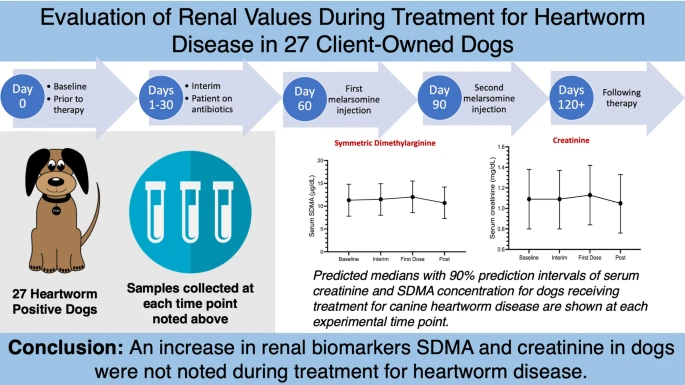Evaluation of renal values during treatment for heartworm disease in 27 client-owned dogs

Background: Canine heartworm disease (CHD) caused by Dirofilaria immitis remains a common preventable disease with increasing incidence in some parts of the USA. The treatment guidelines of the American Heartworm Society (AHS) currently recommend monthly macrocyclic lactone administration, 28 days of doxycycline given orally every 12 h and three injections of melarsomine dihydrochloride (1 injection on day 2 of treatment followed 30 days later by 2 injections 24 h apart). Minocycline has also been utilized when doxycycline is unavailable. The systemic effects of CHD, which particularly impact cardiac and renal function, have been described, with infected dogs often experiencing renal damage characterized by an increase in serum concentrations of renal biomarkers. Although the AHS treatment protocol for CHD has been shown to be safe and effective in most cases, the potential for complications remains. No study as of yet has evaluated changes in symmetric dimethylarginine (SDMA), a sensitive marker of renal function, during treatment for CHD. The purpose of the present study was to evaluate renal function in dogs by measuring serum creatinine and SDMA concentrations during the adulticide treatment period.
Methods: Serum creatinine and SDMA concentrations were measured in 27 client-owned dogs affected by CHD at the following time points: prior to starting doxycycline or minocycline therapy (baseline), during doxycycline or minocycline therapy (interim), at the time of the first dose of melarsomine (first dose), at the time of the second dose of melarsomine (second dose) and at the dog’s follow-up visit after treatment, occurring between 1 and 6 months after completion of therapy (post-treatment). Concentrations of creatinine and SDMA were compared between time points using a mixed effects linear model.
Results: Mean SDMA concentrations following the second dose of melarsomine were significantly lower (-1.80 ug/dL, t-test, df = 99.067, t = -2.694, P-Value = 0.00829) than baseline concentrations. There were no other statistically significant differences in the concentration of either biomarker between the baseline and the other time points in CHD dogs undergoing treatment.
Conclusions: The results suggest that the current AHS protocol may not have a substantial impact on renal function.
C Autumn M Vetter, Alison G Meindl, Bianca N Lourenço, Michael Coyne, Corie Drake, Rachel Murphy, Ira G Roth, Andrew R Moorhead. Parasit Vectors. 2023 Jun 9;16(1):191. doi: 10.1186/s13071-023-05779-0.
